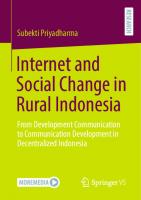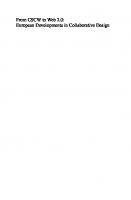Credit and Debt in Indonesia, 860-1930: From Peonage to Pawnshop, from Kongsi to Cooperative 9789812308474
Credit and debt are practical concerns of all times and places. They are also increasingly important topics in economic
188 37 5MB
English Pages 200 [213] Year 2009
Contents
Preface
Contributors
1. Credit and Debt in Indonesian History: An Introduction
2. Preliminary Notes on Debt and Credit in Early Island Southeast Asia
3. “Following the Debt”: Credit and Debt in Southeast Asian Legal Theory and Practice, 1400–1800
4. Credit among the Early Modern To Wajoq
5. Money in Makassar: Credit and Debt in an Eighteenth-Century VOC Settlement
6. Money and Credit in Chinese Mercantile Operations in Colonial and Precolonial Southeast Asia
7. A Colonial Debt Crisis: Surabaya in the Late 1890s
8. Credit and the Colonial State: The Reform of Capital Markets on Java, 1900–30
Appendix
Index
Recommend Papers

- Author / Uploaded
- David Henley (editor)
- Peter Boomgaard (editor)
File loading please wait...
Citation preview
CREDIT AND DEBT IN INDONESIA,
860-1930
The KITLV/Royal Netherlands Institute of Southeast Asian and Caribbean Studies has specialized in collecting information and advancing research on the present and former Dutch colonies and their surroundings since 1851. Today it is an authoritative research institute focussing on Southeast Asia, in particular Indonesia, and the Caribbean, especially Suriname, the Dutch Antilles and Aruba. Its collections, publications and research encompass the humanities and the social sciences, ranging from colonial history to present-day social issues. KITLV houses sizeable and diverse collections, a leading publishing unit, and changing research projects. KITLV Press is the publishing department of the KITLV/Royal Netherlands Institute of Southeast Asian and Caribbean Studies. It specializes in scholarly monographs and other books on the anthropology, art, economics, history, linguistics and literature of Southeast Asia, with special emphasis on Indonesia, and the Caribbean.
The Institute of Southeast Asian Studies (ISEAS) was established as an autonomous organization in 1968. It is a regional centre dedicated to the study of socio-political, security and economic trends and developments in Southeast Asia and its wider geostrategic and economic environment. The Institute’s research programmes are the Regional Economic Studies (RES, including ASEAN and APEC), Regional Strategic and Political Studies (RSPS), and Regional Social and Cultural Studies (RSCS). ISEAS Publishing, an established academic press, has issued almost 2,000 books and journals. It is the largest scholarly publisher of research about Southeast Asia from within the region. ISEAS Publishing works with many other academic and trade publishers and distributors to disseminate important research and analyses from and about Southeast Asia to the rest of the world.
00 C&DI FM.indd 2
2/16/09 11:02:41 AM
CREDIT AND DEBT IN INDONESIA, 860-1930 From Peonage to Pawnshop, from Kongsi to Cooperative Edited by David Henley & Peter Boomgaard
The Netherlands
Institute of Southeast Asian Studies Singapore
First published in Singapore in 2009 by ISEAS Publishing Institute of Southeast Asian Studies 30 Heng Mui Keng Terrace Pasir Panjang Road Singapore 119614 E-mail: [email protected] Website: Co-published for distribution in Europe by KITLV Press P.O. Box 9515 2300 RA Leiden The Netherlands All rights reserved. No part of this publication may be reproduced, translated, stored in a retrieval system, or transmitted in any form or by any means, electronic, mechanical, photocopying, recording or otherwise, without the prior consent of the Institute of Southeast Asian Studies. © 2009 Institute of Southeast Asian Studies, Singapore The responsibility for facts and opinions in this publication rests exclusively with the authors and their interpretations do not necessarily reflect the views or the policy of the publishers or their supporters. ISEAS Library Cataloguing-in-Publication Data Henley, David. Credit and debt in Indonesia, 860–1930 : from peonage to pawnshop, from kongsi to cooperative / David Henley and Peter Boomgaard. 1. Consumer credit—Indonesia. 2. Moneylenders—Indonesia. I. Title. II. Boomgaard, Peter. HG3756 I5H51 2009 ISBN 978-981-230-846-7 (hard cover) ISBN 978-981-230-847-4 (PDF) ISBN 978-90-6718-350-5 (KITLV Press) Cover illustration: Government pawnshop, Garut, West Java, 1903 (from a contemporary postcard in the private collection of Peter Boomgaard) Typeset by International Typesetters Pte Ltd Printed in Singapore by Seng Lee Press Pte Ltd
00 C&DI FM.indd 4
2/16/09 11:02:42 AM
Contents Preface
vii
Contributors
viii
1. Credit and Debt in Indonesian History: An Introduction by David Henley
1
2. Preliminary Notes on Debt and Credit in Early Island Southeast Asia by Jan Wisseman Christie
41
3. “Following the Debt”: Credit and Debt in Southeast Asian Legal Theory and Practice, 1400–1800 by Peter Boomgaard
61
4. Credit among the Early Modern To Wajoq by Kathryn Anderson Wellen
80
5. Money in Makassar: Credit and Debt in an EighteenthCentury VOC Settlement by Heather Sutherland
102
6. Money and Credit in Chinese Mercantile Operations in Colonial and Precolonial Southeast Asia by Kwee Hui Kian
124
7. A Colonial Debt Crisis: Surabaya in the Late 1890s by Alexander Claver
143
00 C&DI FM.indd 5
2/16/09 11:02:42 AM
vi
Contents
8. Credit and the Colonial State: The Reform of Capital Markets on Java, 1900–30 by Jan Luiten van Zanden
160
Appendix
178
Index
191
00 C&DI FM.indd 6
2/16/09 11:02:42 AM
Preface This book has its origins in a KITLV (Royal Netherlands Institute of Southeast Asian and Caribbean Studies) research project entitled “Credit, Risk, and the Economy of Debt: Indonesian Trajectories” (CREDIT), in which we have been the principal participants, and in a discussion panel on “Credit and Debt in Southeast Asia, Past and Present”, which we organized at the Fourth Conference of the European Association of Southeast Asian Studies (EUROSEAS) in Paris in September 2004. Besides six pieces which — in most cases after much revision — became chapters included here, the Paris panel also included papers by Andi Faisal Bakti, Greg Bankoff, Pramuan Bunkanwanicha, Caleb Kwong, Martin Ramstedt, and Willem Wolters. We remain grateful to these scholars for their input and insights, some of which are indirectly reflected in the present volume. Our thanks go also to Anne Booth, Thomas Lindblad, and other members of the panel audience for their critical and constructive comments. Two of our eight chapters, those by Jan Wisseman Christie and Heather Sutherland, did not originate in Paris, but were written after the conference at our request. We are particularly grateful to these contributors, without whom the range of topics and periods covered would have been much less adequate. In addition we would like to thank Rosemary Robson, for improving the English in some of the pieces; the staff of the KITLV, for their always cheerful assistance when we were in search of publications and illustrations; and Triena Ong of ISEAS Publishing, for her help, and forbearance, during the reviewing and editing process. David Henley and Peter Boomgaard
00 C&DI FM.indd 7
2/16/09 11:02:42 AM
Contributors Peter Boomgaard ([email protected]) was trained as an economic and social historian. He is currently Professor of Environmental History of Southeast Asia at the University of Amsterdam, and a senior researcher at the Royal Netherlands Institute of Southeast Asian and Caribbean Studies (KITLV) in Leiden. His books include Frontiers of Fear: Tigers and People in the Malay World, 1600–1950 (2001) and Southeast Asia: An Environmental History (2007). Jan Wisseman Christie ([email protected]) took her first degree in Indo-Iranian Studies at the University of Pennsylvania, and obtained her doctorate in Art and Archaeology of Southeast Asia from the School of Oriental and African Studies (SOAS) in London in 1982. She recently retired from her position as Senior Lecturer and Honorary Professor in the Centre for South-East Asian Studies at the University of Hull, and now holds a professorial research fellowship at SOAS. She has written on diverse aspects of early Javanese states, and is at present completing a register of the inscriptions of the early state of Mataram in Java. Alexander Claver ([email protected]) studied history at Utrecht University, where he specialized in nineteenth- and twentieth-century Dutch economic and business history. In 2006 he obtained his doctorate from the Vrije Universiteit in Amsterdam with a thesis entitled “Commerce and Capital in Colonial Java”, focusing on trade finance and commercial relations between Europeans and Chinese during the nineteenth and early twentieth centuries. His research interests also include entrepreneurship and corporate strategy in contemporary Southeast Asia. At present he is working on Indonesian legal history, as well as the history of the Armenians in the Netherlands Indies. David Henley ([email protected]) is a researcher at the Royal Netherlands Institute of Southeast Asian and Caribbean Studies (KITLV) in Leiden.
00 C&DI FM.indd 8
2/16/09 11:02:43 AM
Contributors
ix
He has written on diverse aspects of Indonesian history. Among his publications are Fertility, Food and Fever: Population, Economy and Environment in North and Central Sulawesi, 1600–1930 (2005) and (as editor and contributor) The Revival of Tradition in Indonesian Politics: The Deployment of Adat from Colonialism to Indigenism (2007). Kwee Hui Kian ([email protected]) is Assistant Professor of History at the University of Toronto. Her research focuses on transnational commercial and social-cultural networks in Southeast Asia, in particular those of the Overseas Chinese in Malaysia, Singapore, and Indonesia. Her publications include The Political Economy of Java’s Northeast Coast, c. 1740–1800: Elite Synergy (2006). Heather Sutherland ([email protected]) is Professor of NonWestern History at the Vrije Universiteit in Amsterdam, where she teaches Southeast Asian and Indian Ocean history, as well as historiography. Her recent publications include “Trade, Court and Company: Makassar in the Later Seventeenth and Early Eighteenth Centuries”, in Hof en Handel: Aziatische Vorsten en de VOC 1620–1720, edited by Elsbeth Locher-Scholten and Peter Rietbergen (2004); and “The Problematic Authority of (World) History”, Journal of World History 18 (2007): 491–521. Kathryn Anderson Wellen ([email protected]) is coordinator of the Southeast Asia team in the Asian Division at the Library of Congress (Washington, D.C.). Her interest in Wajorese commerce stems from her research for her 2003 University of Hawai’i doctoral dissertation, “The Open Door: Early Modern Wajorese Statecraft and Diaspora”. She recently published an article on contemporary Bruneian political ideology entitled “Melayu Islam Beraja: Brunei’s Tripartite Ideology”, in Reflections in Borneo Rivers, edited by Chong Shin and others (2006). Jan Luiten van Zanden ([email protected]) is Professor of Economic History at Utrecht University and a senior researcher at the International Institute of Social History in Amsterdam. He has published widely on the economic history of Western Europe since the Middle Ages. In 2003 the Netherlands Organisation for Scientific Research (NWO) awarded him the Spinoza Prize for his research. He is currently working on a project comparing economic growth performance in Europe and Indonesia. The resulting publications to date include “Rich and Poor before the Industrial Revolution:
00 C&DI FM.indd 9
2/16/09 11:02:43 AM
x
Contributors
A Comparison Between Java and the Netherlands at the Beginning of the 19th Century”, Explorations in Economic History 40 (2003): 1–23; and “On the Efficiency of Markets for Agricultural Products: Rice Prices and Capital Markets in Java, 1823–1853”, Journal of Economic History 64 (2004): 1028–55.
00 C&DI FM.indd 10
2/16/09 11:02:43 AM
Chettiar Moneylender of the Straits Settlements (Malaya), circa 1890 SOURCE: KITLV Image Collection, 6539
00 photos.indd 1
2/4/09 9:11:06 AM
The Guntur Inscription, 907 A.D.
SOURCE: Collectie Wereldmuseum Rotterdam, no. 24505
Last pages of a palm leaf manuscript — a so-called lontar — of the early sixteenthcentury Javanese law text Agama, written in Balinese script and dating from before 1876. SOURCE: Leiden University Library, Oriental Manuscripts Collection LOr 2215
00 photos.indd 2
2/4/09 9:11:10 AM
(Top) Chinese Temple in Makassar: Klenteng Ibu Agung Bahari (Thian Ho Kung, Tian Hou Gong). Built in the early eighteenth century, dedicated to the Fujian Protectoress of Seafarers. This photo is from circa 1900. SOURCE: KITLV Image Collection, 7556
(Bottom) Late Eighteenth-Century House in Makassar, photographed circa 1920 SOURCE: KITLV Image Collection, 9932
00 photos.indd 3
2/4/09 9:11:13 AM
00 photos.indd 4
2/4/09 9:11:15 AM
SOURCE: Sketch by J.M. Aubert in the Rijksmuseum, Amsterdam, inventory no. RP–T–00–3234
Makassar in 1750
'x.
·~t~ ; ~~.. ~~~~~. J.Z; ~ ~..... ~ '""P ~ . 1-< ~~~~~. (~... ~i~ ~~~~,;p, - "' ~ :£·~ ""~ -~~ ~









